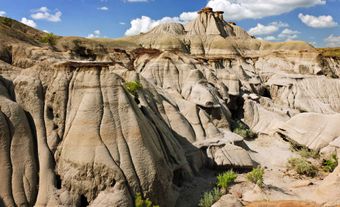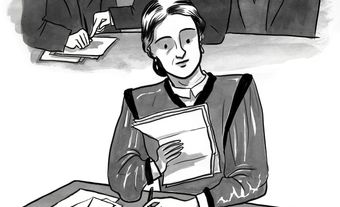Alberta joined Confederation along with Saskatchewan in 1905, when the two new provinces were created out of a section of the Northwest Territories.
First Nations
Alberta was first occupied by several First Nations, including the Siksika (Blackfoot), Kainai (Blood), Piikuni (Peigan) and Gros Ventre. Other groups, including the Kootenay and the Crow, made expeditions into the land to hunt bison and go to war. The Tsuu T’ina, a branch of the Beaver, occupied central and northern parts of the land, while the north was used by the Slavey. People first lived in the area around 5000 BCE.
Many of the First Nations traded with the Hudson's Bay Company (HBC) and the North West Company beginning in the mid-1700s, when European explorers began establishing fur-trading posts. At that time, the area was divided between Rupert's Land and the Northwest Territories — vast lands over which Britain claimed political and economic control.
Fears of United States Expansion
In the 1850s and 1860s, with the fur trade in decline, the British government and leaders in British North America became interested in the agricultural potential of the area, particularly the southern plains east of the Rockies. In 1867, the Dominion of Canada was created. Worried that an expansionist United States would try to annex the West, the Canadian government in Ottawa decided to solidify its hold on the territory.
In 1870, Canada purchased Rupert's Land and the North-West from the HBC, and labelled the entire western and Arctic region the Northwest Territories. The province of Manitoba was created out of the area that same year.
In 1874, Canada began asserting its presence in what would become Alberta, sending the North West Mounted Police across the Prairies to present-day Lethbridge to establish Fort Macleod. In 1875, the Mounties also built forts in present-day Calgary and Edmonton. Meanwhile, the Canadian government negotiated land treaties with the First Nations.
European Immigration Booms
The Canadian Pacific Railway reached Calgary in 1883, but European settlement remained slow, with only about 1,000 non-Aboriginal people living in what is now Alberta. In 1896, however, the flood gates opened as new and fast-maturing varieties of hard spring wheat drew settlers from Canada, the United States and Europe. By 1901, the population had risen to 73,022; by 1911 it was 373,943.
In 1897, Canada changed the way the Northwest Territories were administered, creating an executive council and granting responsible government. Political leaders such as Frederick William Haultain pushed for full provincial status.
Two Provinces or One?
Prime Minister Wilfrid Laurier met with Haultain and James Hamilton Ross, another member of the Territorial legislature. Haultain and Ross drew up a bill to unify the administrative districts of Alberta, Saskatchewan, Assiniboia and Athabasca into one large western province. After further negotiations, it was decided that the proposed province would be too big to administer, and so it was split into Alberta and Saskatchewan.
Canada adopted the Alberta Act and the Saskatchewan Act on 1 September 1905, and the new provinces — Canada's 8th and 9th — entered Confederation. Edmonton became Alberta's capital.
Ottawa kept control of crown lands and natural resources, arguing that unlike earlier provinces, Alberta had never owned the lands. Alberta politicians fought to change that rule and finally took control of the crown lands and resources in 1930.

 Share on Facebook
Share on Facebook Share on X
Share on X Share by Email
Share by Email Share on Google Classroom
Share on Google Classroom







